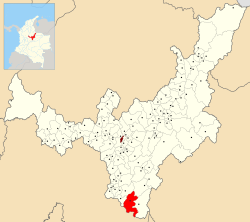Santa María, Boyacá
Santa María, Boyacá | |
|---|---|
Municipality and town | |
 Location of the municipality and town of Santa María in the Boyacá Department of Colombia | |
| Coordinates: 4°51′36″N 73°15′46″W / 4.86000°N 73.26278°W | |
| Country | |
| Department | Boyacá Department |
| Province | Neira Province |
| Government | |
| • Mayor | Pablo Antonio Bernal Sánchez (2020-2023) |
| Time zone | UTC-5 (Colombia Standard Time) |
Santa María is a town and municipality in the Colombian Department of Boyacá, part of the subregion of the Neira Province.
Paleontology
[edit]The dinosaur footprints in Santa María, were discovered in 2017 by students from the Universidad de los Andes.[1] These remarkable tracks are located in the area known as "Pozo de la Calavera." The footprints, preserved in rocky surfaces, date back to the Cretaceous period, around 130 million years ago.[2] The discovery at Pozo de la Calavera has become an important paleontological site, offering valuable insights into ancient dinosaur behavior and drawing both researchers and tourists interested in Colombia's prehistoric past.
Climate
[edit]Santa María has a tropical monsoon climate (Am) with moderate to heavy rainfall from November to March and heavy to extremely heavy rainfall from April to October. It is the second wettest place in the department of Boyacá.
| Climate data for Santa María | |||||||||||||
|---|---|---|---|---|---|---|---|---|---|---|---|---|---|
| Month | Jan | Feb | Mar | Apr | May | Jun | Jul | Aug | Sep | Oct | Nov | Dec | Year |
| Average rainfall mm (inches) | 54.5 (2.15) |
105.0 (4.13) |
189.3 (7.45) |
456.1 (17.96) |
631.4 (24.86) |
693.0 (27.28) |
628.0 (24.72) |
542.3 (21.35) |
431.8 (17.00) |
423.5 (16.67) |
317.5 (12.50) |
171.2 (6.74) |
4,643.6 (182.81) |
| Average rainy days | 9 | 10 | 15 | 23 | 28 | 28 | 28 | 27 | 23 | 23 | 21 | 16 | 251 |
| Source: IDEAM[3] | |||||||||||||
References
[edit]- ^ "El misterio de las huellas en el pozo La Calavera | Uniandes". www.uniandes.edu.co (in Spanish). Retrieved 2024-12-12.
- ^ "En Boyacá están las huellas mejor conservadas del dinosaurio herbívoro Iguanodóntidos de toda Sudamérica y África - Boyacá 7 Días" (in Spanish). 2023-08-03. Retrieved 2024-12-12.
- ^ "Data". www.ideam.gov.co. Retrieved 2020-08-23.

